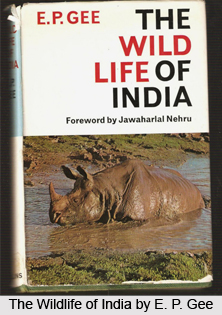 Edward Pritchard Gee (E. P. Gee) was an Anglo-Indian tea-planter and an unpaid naturalist in Assam. He is remembered as an influential naturalist and wildlife conservationist of India. Though not a prominent scientist, this Assam based tea-planter and naturalist had a critical presence. Soon after Independence, he was among the first to assess threats to vanishing species in diverse ecologies and outline remedial measures. Edward Pritchard Gee was born in the year 1904 and was Cambridge educated.
Edward Pritchard Gee (E. P. Gee) was an Anglo-Indian tea-planter and an unpaid naturalist in Assam. He is remembered as an influential naturalist and wildlife conservationist of India. Though not a prominent scientist, this Assam based tea-planter and naturalist had a critical presence. Soon after Independence, he was among the first to assess threats to vanishing species in diverse ecologies and outline remedial measures. Edward Pritchard Gee was born in the year 1904 and was Cambridge educated.
Contributions of Edward Pritchard Gee
Edward Pritchard Gee was an early fire-fighter. He worked in close association with the authorities, trying to devise ways and means of protecting and expanding the few wildlife reserves that existed in India. His first published piece was a brief note in 1933 on a species of hornbill in the forests of Assam. Though only in his late twenties, he had already spent five years as the manager of a tea garden. With only a break for service in the British Indian Army in World War II, he spent virtually all his adult life in Assam. As a tea planter, he was part of a highly powerful group of land managers, whose ties with the provincial administration were very close. The tea plantations not only covered large expanses of land, but were also vital to the local economy. Never a serious big game hunter, Gee was an ardent participant in that other sport of all naturalists that is angling. He was of the belief that there is no place for cattle in a sanctuary because it would evoke a sense of disappointment in the tourists who had come for exploring wild animals.
Later, Edward Pritchard Gee became a non-official member of the Indian Board for Wildlife (IBWL) which first met in 1952 and still remains the apex body that advises the Union government on wildlife matters. It is said that the 1950s were not a time when wildlife was on anyone`s priority list either in Delhi or in other states of India. A prominent Inspector General of Forests openly proclaimed that no man was fit to take charge of a Forest Division until he had shot dead a tiger. Gee opposed and as early as the mid 1950s, he came up with an alternate fitness examination for the foresters. He suggested by saying that no one should take charge of a Forest Division until he had caught fish with rod and line in a Reserved Forest. Moreover, angling could also serve the same purpose as licensed hunting. Gee wrote extensively on the role of foresters as protectors of wildlife, for he saw no option but to rely on their goodwill. He emphasised on the role of foresters as protectors of forests. Edward Pritchard Gee wrote that, "Fifty years ago it might have been alright. But if every Divisional Forest Officer in India today were to bag a tiger, there would be no tigers left. Angling involved no such harmful side effects. A forester out on foot would easily be able to crack down on, irregularities, trespass, unlawfully dropped trees, stolen timber, poacher`s machines and fishing huts." Edward Pritchard Gee hoped to put wildlife preservation on top of the agenda in some key tracts of land. He believed that the success of conservation hinged on the cooperation between the forester and the forest ministers in a state and that the federal government could only give advice and aid.
In the last two decades of his life, Gee visited various field sites to assess the situation of imperilled species and habitats. Before this, he had participated in the first rhino count in Assam in the year 1948, later doing a rapid assessment of the status of the species in the grasslands of Nepal. Wildlife surveys took him far beyond his adopted home state of Assam. In general Gee was a `large animals` man`, a point reflected in the chapter-titles of his only book, `The Wildlife of India`. This did not prevent him from being an enthusiastic bird-watcher and he published records of several small mammals too. But these were peripheral to his vision. Gee`s work anticipated the preoccupations of some conservationists of the present day, prioritising a few key species and their habitat for protection. In each site Gee visited as part of his surveys, he outlined the inadequacies of its machinery for protection and suggested remedial measures. In the first post 1947 decade, especially in the former princely states, things were being rebuilt from scratch. He closely monitored the recovery of the rare swamp deer and the build-up of rhino numbers in Kaziranga after Independence.
After taking retirement from tea planting, Gee settled in Shillong and there he assembled a finest orchid collection. Edward Pritchard Gee died in the year 1968.



















